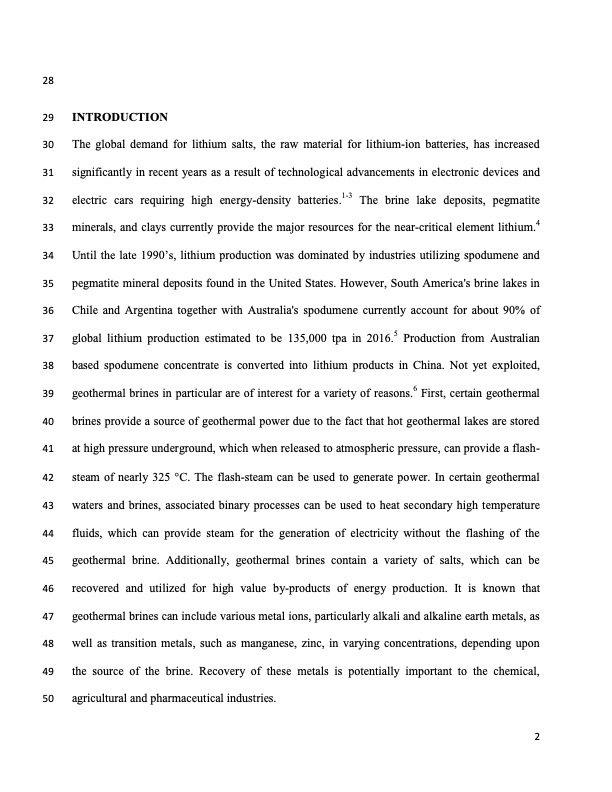
PDF Publication Title:
Text from PDF Page: 002
28 29 INTRODUCTION 30 The global demand for lithium salts, the raw material for lithium-ion batteries, has increased 31 significantly in recent years as a result of technological advancements in electronic devices and 32 electric cars requiring high energy-density batteries.1-3 The brine lake deposits, pegmatite 33 minerals, and clays currently provide the major resources for the near-critical element lithium.4 34 Until the late 1990’s, lithium production was dominated by industries utilizing spodumene and 35 pegmatite mineral deposits found in the United States. However, South America's brine lakes in 36 Chile and Argentina together with Australia's spodumene currently account for about 90% of 37 global lithium production estimated to be 135,000 tpa in 2016.5 Production from Australian 38 based spodumene concentrate is converted into lithium products in China. Not yet exploited, 39 geothermal brines in particular are of interest for a variety of reasons.6 First, certain geothermal 40 brines provide a source of geothermal power due to the fact that hot geothermal lakes are stored 41 at high pressure underground, which when released to atmospheric pressure, can provide a flash- 42 steam of nearly 325 C. The flash-steam can be used to generate power. In certain geothermal 43 waters and brines, associated binary processes can be used to heat secondary high temperature 44 fluids, which can provide steam for the generation of electricity without the flashing of the 45 geothermal brine. Additionally, geothermal brines contain a variety of salts, which can be 46 recovered and utilized for high value by-products of energy production. It is known that 47 geothermal brines can include various metal ions, particularly alkali and alkaline earth metals, as 48 well as transition metals, such as manganese, zinc, in varying concentrations, depending upon 49 the source of the brine. Recovery of these metals is potentially important to the chemical, 50 agricultural and pharmaceutical industries. 2PDF Image | Recovery of Lithium from Geothermal Brine Li AL

PDF Search Title:
Recovery of Lithium from Geothermal Brine Li ALOriginal File Name Searched:
1424451.pdfDIY PDF Search: Google It | Yahoo | Bing
Product and Development Focus for Infinity Turbine
ORC Waste Heat Turbine and ORC System Build Plans: All turbine plans are $10,000 each. This allows you to build a system and then consider licensing for production after you have completed and tested a unit.Redox Flow Battery Technology: With the advent of the new USA tax credits for producing and selling batteries ($35/kW) we are focussing on a simple flow battery using shipping containers as the modular electrolyte storage units with tax credits up to $140,000 per system. Our main focus is on the salt battery. This battery can be used for both thermal and electrical storage applications. We call it the Cogeneration Battery or Cogen Battery. One project is converting salt (brine) based water conditioners to simultaneously produce power. In addition, there are many opportunities to extract Lithium from brine (salt lakes, groundwater, and producer water).Salt water or brine are huge sources for lithium. Most of the worlds lithium is acquired from a brine source. It's even in seawater in a low concentration. Brine is also a byproduct of huge powerplants, which can now use that as an electrolyte and a huge flow battery (which allows storage at the source).We welcome any business and equipment inquiries, as well as licensing our turbines for manufacturing.| CONTACT TEL: 608-238-6001 Email: greg@infinityturbine.com | RSS | AMP |